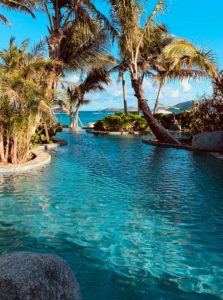The British Virgin Islands (BVI) are a Caribbean British Overseas Territory. They are located in the Leeward Islands, 100 miles (160 km) to the east of Puerto Rico and the U.S. Virgin Islands and north-west of Anguilla, and they are home to just 36,000 people. It is a small territory but it is comprised of 4 larger islands and 50 smaller ones.

The main tourist town is Cane Garden Bay on the island of Tortola. Here you can rent a boat, swim, snorkel or kayak in the turquoise waters during the day, and enjoy diverse food options and plenty of happy hours and live music in the evenings. The most popular tourist attraction the Virgin Islands are The Baths in Virgin Gorda. These are series of tiny coves formed by giant granite boulders. Visitors can swim or wade through the maze of boulders, and the contrast of colour between the white rocks and aquamarine blue seas creates a spectacular sight. Another popular activity is sailing. You can charter a boat or join a day cruise to explore some of smaller islands and enjoy the natural sights of the more remote islands, such as fine beaches and flamingos.
Scuba divers of course, flock to the islands too. The dive sites of the British Virgin Islands are among the best in the Caribbean, especially for those that enjoy wrecks. BVI is the Caribbean’s top spot for wreck dives, the island of Anegada in particular, and has over 300 wrecks to discover. The Rhone is worth a mention alone, as it is ranked as one of the best wreck dives in the world as it is covered in a colourful kaleidoscope of corals. Elsewhere there are seamounts, caverns, canyons and boulder formations. The seas are home to barracuda, turtles. eagle rays, southern stingrays, nurse sharks. schools of jacks, as well as masses of colorful reef fish.
In 2019, 895,000 international tourists arrived in BVI, 65% of which came on cruise ships. This represented a big increase after 2 hurricane affected years, and puts it in the top 20 ranked Caribbean tourist destinations. Historically tourism accounts for 30% of GDP and the territory is one of the more affluent in the Caribbean. However its reliance upon tourism meant that the arrival of the COVID-19 pandemic had a devastating effect on the local people.
The first case was confirmed on 25 March 2020, and the territory responded by announcing a complete lockdown on 8 April. The first death was recorded on 18 April 2020. Further cases occurred through 2020 and the government switched to midnight-dawn curfews, quarantines for arrivals, and eventually a ban on all arrivals until 2 June 2020. Since the islands only have flights from the neighboring islands of Puerto Rico and US Virgin Islands, arrivals were heavily restricted in any case as a result of the travel measures those territories imposed themselves. Businesses and bars began to re-open by October 2020, and tourists were once again welcome from 15 May 2021. Entry requirements are quite complicated and vary depending on your vaccination status. You can find all the official details on the Government of the Virgin Islands![]() website.
website.
To date there have been 6,350 confirmed cases of COVID and only 62 reported deaths. This makes it one of the safest places in the world in terms of official death rate from COVID – it ranks 206 out of 228 in the world of highest death rates. Vaccine take up has not been great. 50% of the population were “fully vaccinated” by September 2021, but this has only increased to 59% to date, as interest and concern of the virus wanes around the world.
The British Virgin Islands are the latest addition to our worldwide diving destinations. Why not shake off those travel blues and take advantage of the great special offers available. Join our BVI liveaboard cruises from June 2022 onwards to dive its wondrous wrecks and more.